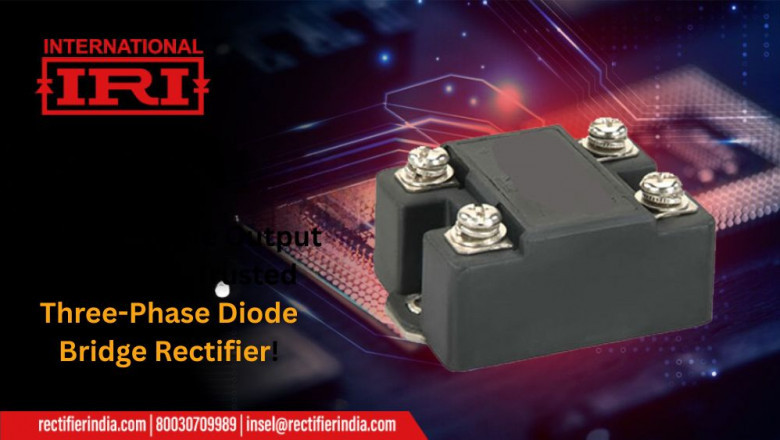views
In the world of industrial and electrical applications, efficiency and reliability are non-negotiable. Whether you're running heavy machinery, powering control systems, or operating high-voltage equipment, your power supply must be clean, stable, and continuous. That’s where the three-phase diode bridge rectifier becomes the hero behind the scenes — quietly converting AC to DC with remarkable consistency.
As modern industries grow increasingly dependent on robust and efficient electrical systems, the three-phase bridge rectifier has become a critical component in a wide range of applications, including motor drives, UPS systems, welding equipment, and automation controls. Its ability to deliver smooth, ripple-minimized DC output from a three-phase AC input makes it the go-to solution for engineers, manufacturers, and industrial designers alike.
What is a Three-Phase Bridge Rectifier?
A three-phase bridge rectifier is an electrical circuit that converts three-phase alternating current (AC) into direct current (DC). Unlike a single-phase rectifier, which works with a standard single-phase input, a three-phase rectifier utilizes three AC lines, providing higher power and more efficient conversion.
The result? A more stable DC output with significantly less ripple, ideal for applications where performance, safety, and precision are paramount.
Why Choose a Three-Phase Full-Wave Rectifier?
A three-phase full-wave rectifier is the most efficient and reliable rectification system for high-power applications. Unlike half-wave rectifiers that utilize only one half of the AC cycle, full-wave rectifiers use both halves — delivering maximum power conversion with minimal energy loss.
Key benefits include:
· Smoother Output Voltage: Lower ripple and consistent DC output
· Higher Efficiency: Better utilization of input AC power
· Compact Design: Higher power output without bulky filters
· Improved Load Handling: Can manage heavy industrial loads effortlessly
These advantages make the three-phase full-wave rectifier ideal for use in industrial motor control, variable frequency drives (VFDs), battery chargers, electroplating systems, and renewable energy inverters.
Why a Diode-Based Solution?
The three-phase diode bridge rectifier is a popular choice due to its simple design, robustness, and cost-effectiveness. Diodes are solid-state devices that allow current to flow in one direction. In a bridge configuration, they work in pairs to direct current through the load in a single direction during each half of the AC cycle.
Benefits of diode-based rectifiers include:
· Low Maintenance: Fewer moving parts means fewer breakdowns
· Reliability: Excellent performance under continuous and high-load conditions
· Heat Resistance: Ideal for operations in demanding industrial environments
· Compact and Lightweight: Easy integration into existing setups
Moreover, with advancements in semiconductor technology, today’s diode rectifiers offer even greater reliability and efficiency at lower costs.
Applications Across Industries
A three-phase diode bridge rectifier is indispensable in a range of sectors:
· Manufacturing: Powers automated machinery, conveyor systems, and PLCs
· Welding Equipment: Supplies clean DC current for consistent welding arcs
· Telecommunications: Ensures uninterrupted power to critical communication infrastructure
· Renewable Energy: Converts solar or wind-generated AC into usable DC
· Transportation: Supports battery charging systems and rail electrification
· Utilities: Assists in voltage regulation and substation control panels
Wherever stable and dependable DC power is needed, you’ll find a three-phase rectifier silently doing its job — powering productivity and precision.
Choosing the Right Rectifier for Your Needs
When selecting a three-phase bridge rectifier, consider these important factors:
· Current Rating: Ensure it can handle the required load current continuously.
· Voltage Rating: Choose a rectifier with a peak inverse voltage (PIV) rating higher than your supply voltage.
· Heat Dissipation: Look for models with built-in or compatible heat sinks for thermal efficiency.
· Mounting Type: Whether panel-mounted or chassis-mounted, ensure it fits your existing system.
· Quality Certification: Opt for products that are ISO, CE, or UL certified to guarantee safety and compliance.
Partnering with a trusted manufacturer or supplier ensures that your rectifier delivers both longevity and consistent performance. Investing in quality up front saves time, money, and operational headaches in the long run.
Future-Proof Your Power Systems
With industries moving toward automation, smart manufacturing, and renewable energy integration, the demand for efficient power conversion is on the rise. A reliable three-phase full-wave rectifier isn’t just a component — it’s a cornerstone of any modern electrical system.
As the push for energy efficiency and cleaner power continues, rectifiers will play an even more crucial role in enabling smart grids, EV charging stations, and off-grid renewable installations. That makes now the perfect time to upgrade or integrate a high-performance three-phase diode bridge rectifier into your operations.
Power with Confidence
In high-demand environments, you can’t afford power fluctuations, equipment failures, or inefficiencies. A three-phase bridge rectifier provides the clean, reliable DC output your systems need to perform at their best — day in and day out. Whether you're setting up new electrical infrastructure or upgrading your existing system, choosing the right rectifier is a decision that impacts performance, safety, and profitability. With proven benefits in efficiency, durability, and cost-effectiveness, the three-phase diode bridge rectifier is the smart choice for professionals who power the world. Clean power begins here. Choose smart. Choose reliable. Choose the rectifier that delivers.






















Comments
0 comment